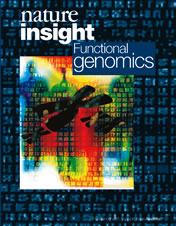Functional genomics
Vol.
405, No. 6788 (15 June 2000).
|![]() PDF
PDF![]() (202
(202![]() K)
K)![]() |
|
 |
Cover
illustration |
Functional genomics has leapt from being a surrealistic, or at least futuristic, concept in the 1980s to an accepted (if not yet everyday) part of science in the year 2000. How has this transformation come about?
Since worldwide efforts to sequence genomes began formally in 1990, astounding technological advances have been introduced. Among the eukaryotes, yeast, worm and fly sequences have been completed, alongside more than 20 prokaryotic genomes. The expected date for completion of the entire human genome is 2003, with a first draft due this autumn. But what is the value of all this sequence data? An inventory of genes will impact molecular medicine the greatest, leading to improved diagnosis of disease and eventually to custom-made drugs tailored to the individual. Sequencing of prokaryotic genomes will aid vaccine design and allow exploration of new microbial energy sources, while knowledge of other animal and plant genomes should enhance agriculture. Gaining the DNA sequences heralds the end of the beginning. The next step in this biological revolution is 'functional genomics', not simply the assignation of function to the identified genes but the organization and control of genetic pathways that come together to make up the physiology of an organism. This month's Nature Insight focuses on the challenges to biology brought about by the avalanche of DNA sequence information.
In 1953, Nature published the structure of the DNA helix. Today, as the first human chromosome sequences appear in our pages, we stand at the brink of the next biological revolution. We hope that our readers will find the following reviews enlightening as well as thought provoking. The sequence for the human chromosomes and published genomes can be accessed online through Nature's Genome Gateway.
Mark Patterson Associate Editor
Ritu Dhand Associate
Editor
| Exploring
genome space OGNJENKA GOGA VUKMIROVIC AND SHIRLEY M. TILGHMAN The completion of entire genome sequences of many experimental organisms, and the promise that the human genome will be completed in the next year, find biology suddenly awash in genome-based data. Scientists are scrambling to develop new technologies that exploit genome data to ask entirely new kinds of questions about the complex nature of living cells.
| 820 | ||
| Protein
function in the post-genomic era DAVID EISENBERG, EDWARD M. MARCOTTE, IOANNIS XENARIOS & TODD O. YEATES
| 823 | ||
| Genomics,
gene expression and DNA arrays DAVID J. LOCKHART AND ELIZABETH A. WINZELER
| 827 | ||
| Proteomics
to study genes and genomes AKHILESH PANDEY AND MATTHIAS MANN
| 837 | ||
| Searching
for genetic determinants in the new millennium NEIL J. RISCH
| 847 | ||
| Pharmacogenetics
and the practice of medicine ALLEN D. ROSES
| 857 | ||
Aventis
and functional genomics
| 866 | ||
